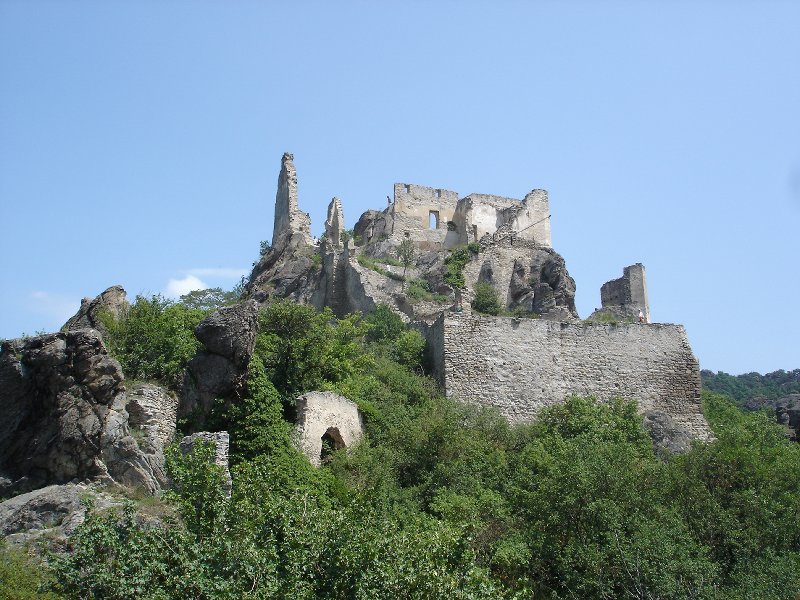

Location: Wachau, Lower Austria
Tel: (02711) 200
Burgruine Dürnstein, also known as Dürnstein Castle or Kuenringerburg (named after the Kuenring family), is a medieval rock castle ruin perched on a rocky hill at 312 meters above sea level in the town of Dürnstein, Lower Austria. Situated in the picturesque Wachau Valley along the Danube River, it forms part of the UNESCO World Heritage Site "Wachau Cultural Landscape." The castle is renowned worldwide for its historical association with the imprisonment of King Richard I of England (Richard the Lionheart) during the late 12th century, symbolizing medieval chivalry, crusades, and political intrigue. Overlooking the charming Baroque town below, with its vineyards and apricot orchards, the ruin offers stunning panoramic views of the Danube and surrounding valleys, making it a key cultural and tourist landmark in Austria's historic heartland.
The origins of Dürnstein Castle trace back to the early 12th century,
when it was constructed around 1130–1145 by Hadmar I of Kuenring, a
ministerialis (unfree knight) in service to Margrave Leopold III of
Austria. The Kuenring family, descending from Azzo of Gobatsburg who
acquired the lands from Tegernsee Abbey in the late 11th century, built
the castle as a strategic fortress to control the Danube trade routes
and defend against invasions. Hadmar I also founded the nearby Zwettl
Abbey, linking the site to ecclesiastical influences.
The castle
gained international fame through its connection to Richard the
Lionheart. In December 1192, during his return from the Third Crusade,
Richard was captured near Vienna by Duke Leopold V of Austria, who
accused him of insulting the Austrian flag at the Siege of Acre and
refusing to share crusade spoils. Imprisoned at Dürnstein from December
1192 to March 1193, Richard was treated relatively well, receiving
troubadours for entertainment. Legends, such as the tale of his minstrel
Blondel discovering him by singing a familiar song that Richard
completed, have romanticized this episode. Richard's release came after
a massive ransom of 150,000 silver marks (about 35 tons of silver) was
paid, though he was briefly transferred to Emperor Henry VI's custody at
Trifels Castle in Germany. This event led to Leopold V's excommunication
by Pope Celestine III for capturing a fellow crusader.
Subsequent
history saw the castle plundered by Hussite forces in 1428 and 1432
during regional conflicts. In 1400, part of the structure was donated to
Augustinian Canons for use as a monastery, later modernized in Baroque
style around 1710. The Kuenring dynasty ended in 1356, after which the
Habsburgs acquired the property. During the Thirty Years' War, Swedish
troops under General Lennart Torstensson conquered and partially
demolished the castle in 1645 via explosives. By 1662, it was
uninhabited but considered a potential refuge during the Austro-Turkish
War (1663–1664). In 1663, Conrad Balthasar von Starhemberg purchased the
ruins, and ownership has remained with his descendants. By 1679, the
castle was fully abandoned and deemed uninhabitable, marking its
transition to a romantic ruin.
As a classic medieval rock castle (Felsenburg), Dürnstein was built
directly onto a steep, isolated slate outcrop, leveraging the natural
terrain for defense and providing commanding views over the Danube
Valley. The structure, erected in the Romanesque style typical of the
12th century, featured thick stone walls, towers, and a central keep,
connected to the town below via a defensive wall that extended from
Dürnstein's city fortifications. This integration emphasized its role in
protecting the Wachau region's trade routes and settlements.
Today,
the ruins consist of fragmented stone walls, remnants of the gate tower,
and portions of the palas (residential hall), overgrown with vegetation
that adds to its atmospheric, fairy-tale-like charm. The site's compact
layout reflects its original function as a fortified residence rather
than a sprawling palace, with later additions like the monastery section
incorporating Baroque elements from the 18th century. The surrounding
landscape, including terraced vineyards and the flowing Danube, enhances
the visual drama, making the castle a symbol of medieval Austria's
rugged beauty.
In its present condition, Burgruine Dürnstein is a well-preserved ruin, stabilized for public access but retaining its decayed, historical authenticity. No major reconstructions have occurred since the 17th century, and it is no longer habitable or used for residential purposes. Instead, it serves as a cultural heritage site within the Wachau UNESCO area, integrated into hiking networks like the Wachau World Heritage Trail, which features 14 stages highlighting natural and historical viewpoints. The ruin occasionally ties into local legends and tourism narratives but does not host formal events or exhibitions, focusing on self-guided exploration and photography.
Burgruine Dürnstein is a highly rated attraction, earning 4.5 out of
5 stars on Tripadvisor based on over 400 reviews, with visitors lauding
its breathtaking views, historical intrigue (especially for fans of
Richard the Lionheart), and the rewarding hike. Many describe it as a
highlight of Danube River cruises or Wachau Valley tours, though some
note the steep climb may be challenging for older or less fit
individuals, suggesting alternatives like viewing from afar. Reviews
emphasize the site's romantic ambiance and the quaint town below, ideal
for combining with wine tastings or abbey visits.
The ruin is freely
accessible year-round with no admission fees or set hours, though
daylight visits are recommended for safety. Access involves a
moderate-to-strenuous 20–40 minute hike from Dürnstein's town center
(elevation gain about 150 meters or 500 feet), along a well-marked trail
requiring sturdy shoes—trail or sports footwear is advised due to
uneven, rocky paths. It's not wheelchair-accessible, and visitors with
mobility issues may struggle. Parking is available in Dürnstein,
reachable by car via the A1 motorway (exit Melk or Krems), train to
Krems followed by bus, or Danube River cruises docking nearby. For
hikers, it's part of the Welterbesteig Wachau trail; more details at
welterbesteig.at or bergfex.at. Combine with exploring Dürnstein Abbey,
local vineyards, or apricot shops for a full experience. Photography is
unrestricted, and the panoramic vistas at sunset are particularly
praised.